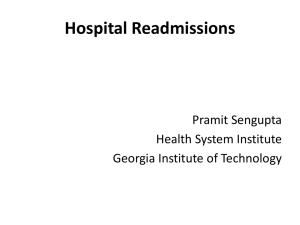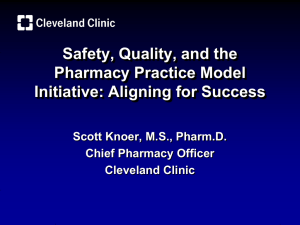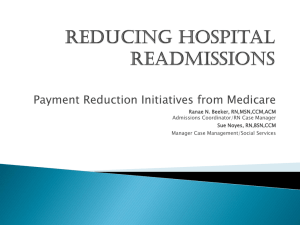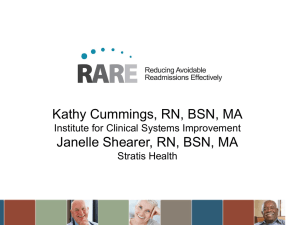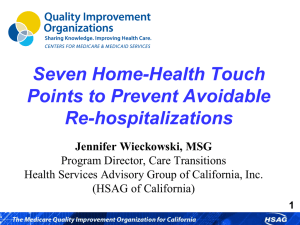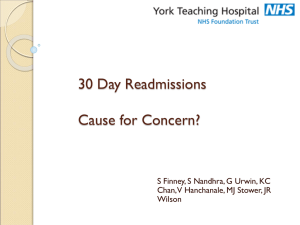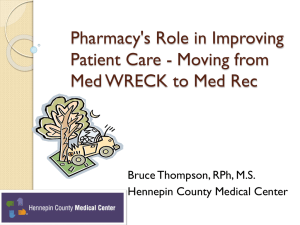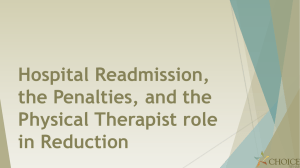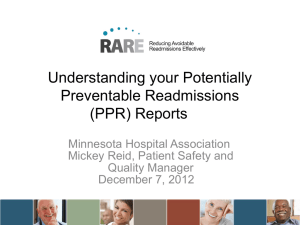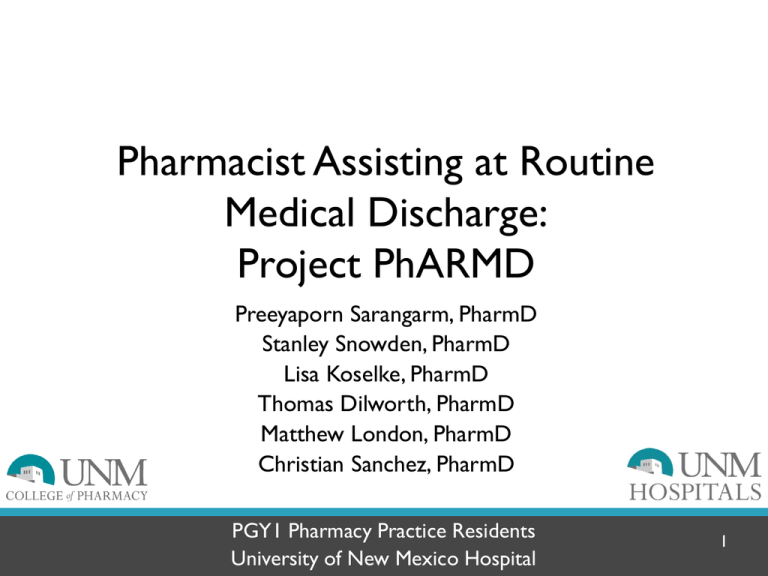
Pharmacist Assisting at Routine
Medical Discharge:
Project PhARMD
Preeyaporn Sarangarm, PharmD
Stanley Snowden, PharmD
Lisa Koselke, PharmD
Thomas Dilworth, PharmD
Matthew London, PharmD
Christian Sanchez, PharmD
PGY1 Pharmacy Practice Residents
University of New Mexico Hospital
1
Background
Approximately 20% of patients experience an
adverse event after discharge
Up
to 60% are medication related and preventable
Results in costly healthcare utilization
Pharmacist discharge counseling has shown mixed
results in reducing health care utilization
Hospital
ED
readmissions
visits
2
Background
The American College of Clinical Pharmacists
reviewed the literature between 2001 and 2005
surrounding clinical pharmacy services (CPSs)
For
every dollar spent on CPSs $4.81 was saved
No study has examined the cost-effectiveness of
an inpatient pharmacist discharge service
Perez A et al. Pharmacotherapy. 2008;28(11): 285e-323e.
3
Background
Hospital Consumer Assessment of Healthcare Providers and
Systems (HCAHPS)
July 2007 Inpatient Prospective Payment System (IPPS) linked to
compliance with HCAHPS
Patient Protection and Affordable Care Act of 2010
HCAHPS will be one of the measures used to calculate
Value-based incentive payments (October 2012)
Value-based incentive purchasing
Patient perception has a significant effect on hospital income
Earnings of $4980 per bed linked to one point gain in satisfaction
Patients with higher satisfaction ratings of hospital services are less
likely to enter into malpractice suits
4
Background
When chronic disease states are treated ineffectively,
complications of the disease may lead to increased use
of hospital, ED, and other medical resources
Medication non-adherence is related to greater
morbidity and mortality in chronic disease
Estimated to increase healthcare costs by over $170 billion
annually in this country
Increased adherence has the potential to generate
medical savings that more than offset the associated
increases in drug costs
Benner J, et al. JAMA. 2002;288:455–61.
O’Connor PJ. Arch Int Med. 2006;166:1802–4.
Sokol MC, et al. Med Care. 2005;43:521–30.
Schlenk EA, et al. Futura Publishing Co; 2001:57–70.
Miller NH. Am J Med. 1997;102:43– 49.
5
Study Objective
Primary Outcome: To evaluate the impact of
pharmacist discharge counseling on a combined
endpoint of 30-day post-discharge hospital
readmissions and ED visits
Secondary Outcomes:
Determine
predictors for readmission/ED visits
Describe the number and type of interventions
Conduct a cost-benefit analysis
Improve patient satisfaction
Increase primary medication adherence
6
Methods
7
Methods: Study Design
Single center, prospective intervention study
Number of patients
Historical
hospital data:
30-day
readmission rate: 12.3%
30-day ED visits: 13.0%
A
Excludes patients who were subsequently admitted
priori power analysis:
292
patients in each study group
33% reduction in the combined endpoint
Power=80%, α=0.05
8
Methods: Patient Selection
Inclusion criteria:
Discharged
from internal medicine service
English or Spanish speaking
Exclusion criteria:
Less
than 18 years of age
Unable or unwilling to receive counseling
Discharged to anywhere other than home
Planned readmission
Previous inclusion into the study
9
Methods: Flow of Patients
Study introduction to patient
Prior to discharge
Control Group:
Usual Discharge Care
Only
Intervention Group:
Usual Care plus
Counseling by a
Pharmacy Resident
Survey given and
collected
Survey given and
collected
36-72 hours postdischarge
30 days postdischarge
Follow-up
Phone Call
Review patients for
readmissions and
ED visits
Review patients for
readmissions and
ED visits
10
Method: Discharge Services
Prescription review
Medication
reconciliation
Completeness of prescriptions
Duplicative, unnecessary or incomplete therapy
Drug interactions
Insurance coverage/ability to pick up medications
Counseling
Medication
information and administration
Side
effects
Disease state education
11
Methods: Survey Distribution
Upon completion of discharge counseling, patients
were given the anonymous English or Spanish
survey
Patients were then left in their room to fill out the
survey without the pharmacist present
Surveys were placed within the provided envelope
by the patient and collected prior to the patient
leaving the hospital
Patients unable or unwilling to complete the
survey were not included in the analysis
12
Methods: Data Collection
Upon discharge:
At 30 days post-discharge:
Patient demographics
Admission information
Number of prior readmissions
Number of medications at discharge
Pharmacist interventions and time spent
Number of hospital readmissions or ED visits and reason/diagnosis
Medication fill history from the UNMH Outpatient Pharmacy for UNM care
patients
Cost data:
Estimated patient charges for readmissions and ED visits
Pharmacist salary plus benefits
Converted charges to costs using UNMH cost to charge ratio
13
Methods: Intervention Classification
Discontinue drug
Therapeutic duplication
Medication without indication
Adverse drug reaction (ADR)
Add drug
Untreated condition
Prevent or treat ADR
Change drug
Drug interaction
Actual or potential ADR
Reverse auto-substitution
Bayley BK, et al. Ther Clin Risk Manag. 2007; 3:695-703.
Change dosing
Incorrect or inappropriate
Drug interaction
Renal adjustment
Hepatic adjustment
Allergies
Allergy updated or clarified
Allergy avoided
Incomplete prescription
Other
14
Methods: Data Analysis
Data was analyzed in SPSS (version 18)
Univariate
analysis:
Chi-square
for categorical variables
T-test for continuous variables
Multivariate
analysis:
Multiple
logistic regression
MANOVA
Nonparametric
Mann-Whitney
analysis:
U test
15
Results: 30-day Readmission and ED visits
Primary Outcome
16
Study Recruitment and Flow
17
Demographics (n=279)
Control
(n=139)
Intervention
(n=140)
P-value
50.4 (16.5)
49.0 (15.8)
0.48
Male
81 (58.3)
75 (53.6)
0.43
Primary Language: English
129 (92.8)
121 (86.4)
0.08
Characteristic
Age, mean (SD), years
Ethnicity
White, non-Hispanic
White, Hispanic
African American
Native American
Other
Marital Status
Single
Married
Separated/Divorced/Widower
*All values reported as n (%) unless specified otherwise
0.30
43 (30.9)
58 (41.7)
7 (5.0)
25 (18.0)
6 (4.3)
46 (32.9)
55 (39.3)
12 (8.6)
16 (11.4)
11 (7.8)
0.23
79 (56.8)
40 (28.8)
20 (14.4)
90 (64.3)
34 (24.3)
16 (11.4)
18
Demographics (n=279)
Characteristic
Control
(n=139)
Intervention
(n=140)
P-value
Current Primary Care Provider
80 (57.8)
84 (60.0)
0.68
Insurance
Private Insurance
Public Insurance
County Provided Healthcare (UNM Care)
No Insurance
19 (13.7)
76 (54.7)
27 (19.4)
17 (12.2)
17 (12.1)
45 (32.1)
42 (30.0)
36 (25.7)
Length of stay, mean (SD), days
6.1 (5.2)
7.3 (8.1)
0.14
Previous admission (within 1 year), mean (SD)
0.7 (1.5)
0.8 (1.6)
0.62
Charleson co-morbidity index score, mean (SD)
3.3 (2.9)
2.9 (2.8)
0.22
57.4 (94.0)
79.9 (229.0)
0.29
Distance from the hospital, mean (SD), miles
*All values reported as n (%) unless specified otherwise
<0.001
19
Intervention Group (n=140)
Declined
(n=23)
16%
30-day Readmissions and ED Visits
(Univariate Analysis)
Control
(n=139)
N (%)
Combined 30-day readmissions and
ED visits
30-day hospital readmission
30-day ED visits
Related readmission or ED visit
Intervention
(n=140)
N (%)
P-value
24 (17.3)
30 (21.4)
0.34
16 (11.5)
11 (7.9)
20 (14.3)
17 (12.1)
0.49
0.24
19/24 (79.2)
23/30 (76.7)
0.83
21
30-day Readmissions and ED Visits
(Multivariate Analysis)
Multivariate logistic regression
Adjusted
for confounders that could potentially
influence the outcome
Factors
No
in univariate analysis with p<0.1: sex and insurance
difference in readmissions and ED visits
OR
1.25 (95%CI 0.67-2.34), p=0.48
22
Conclusion: 30-day Readmissions and
ED visits
Pharmacist discharge counseling services did not
significantly improve 30-day hospital readmissions
and ED visits
23
Results: Predictors for Readmission and ED
Visits
Secondary Outcome
24
Risk Factors for Combined 30-day ED
Visits and Readmissions
No readmission/ED visit
(n=225)
Readmission/ED visit
(n=54)
P value
Age, mean (SD), years
49.7 (15.8)
49.5 (17.5)
0.93
Primary care provider
132 (58.7)
32 (59.3)
0.94
Primary Language: English
202 (89.8)
48 (88.9)
0.85
Male
132 (58.7)
24 (44.4)
0.06
Risk factors
Insurance status
Public Insurance
UNM Care
Private Insurance
No Insurance
Marital status
Married
Single
Separated/Divorced
Widower
0.93
98 (43.6)
54 (24)
30 (13.3)
43 (19.1)
23 (42.6)
15 (27.8)
6 (11.1)
10 (18.5)
0.14
65 (28.9)
135 (60)
17 (7.6)
8 (3.6)
*All values reported as n (%) unless specified otherwise
9 (16.7)
34 (63)
7 (13)
4 (7.4)
25
Risk Factors for Combined 30-day ED
Visits and Readmissions
Risk factors
Ethnicity
White
Hispanic
Black
Native American
Other
No readmission
or ED visit
(n=225)
Readmission
or ED visit
(n=54)
P
value
0.19
73 (32.4)
84 (37.3)
15 (6.7)
37 (16.4)
16 (7.1)
16 (29.6)
29 (53.7)
4 (7.4)
4 (7.4)
1 (1.9)
71.4 (186.14)
57.1 (120.98)
0.59
Length of hospital stay, mean (SD)
6.4 (6.35)
7.7 (8.48)
0.20
Previous hospital admissions, mean (SD)
0.6 (1.18)
1.3 (2.40)
0.002
Charlson comorbidity index, mean (SD)
2.9 (2.73)
3.5 (3.21)
0.19
Meds pre reconciliation, mean (SD)
5.3 (5.36)
6.8 (5.30)
0.17
Meds post reconciliation, mean (SD)
5.5 (5.21)
7.3 (5.06)
0.10
Distance from the hospital, mean (SD), miles
*All values reported as n (%) unless specified otherwise
26
Multivariate Regression
Logistic regression for ED visits and readmissions within 30 days postdischarge
Risk factors
Previous hospital admissions*
No
Yes
OR
95% CI
P value
0.008
-1.26
-1.06-1.49
*Statistically significant (P≤0.05), this regression included risk factors with a P<0.1 (gender,
previous hospitalization)
27
Multivariate Regression
Readmissions within 30-days
Risk factors
OR
95% CI
P value
Length of stay*
1.06
1.01-1.12
0.015
Risk factors
OR
95% CI
P value
Previous hospital admissions*
1.23
1.01-1.48
0.035
Divorced*
5.67
1.42-22.66
0.014
ED visits within 30-days
*Statistically significant (P≤0.05), this regression included risk factors with a P<0.1
28
Conclusion: Predictors
Hospitalizations in the previous year was a
significant predictor for readmissions and ED visits
Divorce and previous hospital admissions were
predictive of ED visits while length of hospital stay
was predictive of readmissions
29
Results: Interventions by Pharmacists
Secondary Outcome
30
Intervention Group (n=140)
Number of Interventions by Type
#
% total Type of Intervention
66
33.3%
Add drug: untreated condition
29
14.6%
Change dosing: incorrect or inappropriate
23
11.6%
Discontinue drug: medication without indication
19
9.6%
Other intervention
15
7.6%
Discontinue drug: therapeutic duplication
12
6.0%
Incomplete prescription
12
6.0%
Cost-savings or third party intervention
10
5.1%
Add drug: prevent or treat adverse drug reaction
12
6.0%
Cost-savings or third party intervention
32
Number of Interventions by Type
(cont.)
#
% total Type of Intervention
6
3.0%
Change dosing: dosage form or route
4
2.0%
Change dosing: renal adjustment
1
0.5%
Change drug: drug interaction
1
0.5%
Change drug: reverse auto-substitution
1
0.5%
Allergy clarified or updated
0
0.0%
Change dosing: hepatic adjustment
0
0.0%
Change dosing: drug interaction
0
0.0%
Allergy avoided
33
Top Interventions
By class:
Anti-infectives
17.79%
Cardiovascular 15.95%
Gastrointestinal 12.98%
Endocrine 11.66%
By medication:
Oxycodone: 7
interventions
Docusate: 7 interventions
Ciprofloxacin, clindamycin, insulin glargine, lisinopril,
sulfamethoxazole-trimethoprim: 4 interventions
34
Intervention Acceptance Rate
198
Total number of interventions attempted
- 13
Interventions not accepted
185
Total number of accepted interventions
93.4% Intervention acceptance rate
35
Unaccepted Interventions
Intervention
# unaccepted/total
% unaccepted
Add drug:
Untreated condition
4/66
6.1%
Discontinue drug:
Medication w/o indication
4/23
17.4%
Cost-savings/third-party
2/12
16.7%
Change dosing: incorrect
1/29
3.4%
Reverse auto-sub
1/1
0%
Change dosing: renal
1/4
25%
36
Predictors for Need for Intervention
Multivariate logistic regression to identify
predictors for ≥ 1 pharmacist intervention
Age, sex, ethnicity, language, length of stay, previous
admission in past year, having a primary care
provider at admission, number of medications, and
Charlson score were NOT predictors for
intervention
37
Conclusion: Interventions by
Pharmacists
Nearly 60% of patients discharge prescriptions
warranted some change by a pharmacist
Majority of interventions (93%) accepted and
implemented by physician
No predictors for which patients needed most
interventions
Pharmacy
discharge services beneficial to all patients
38
Results: Cost-benefit Analysis
Secondary Outcome
39
Cost-Benefit Analysis
Net benefit = (CC- CI)
Benefit to cost ratio = (CC- CI)/C
A
ratio greater than 1.0 will demonstrate an overall
benefit of the intervention
CI = readmission and ED costs, intervention
CC = readmission and ED costs, control
C = cost of pharmacist intervention
40
Mean Costs per Patient
Mean (SD) in dollars
All patients
Combined
readmissions and
ED visits
Only patients
who incurred
cost
Combined
readmissions and
ED visits
Difference in dollars
Control
(n=139)
Intervention
(n=140)
(95% CI)
$1,897.65
($5,998.90)
$2,859.39
($10,194.97)
$961.74 (-$2,935.04 to
$1,011.56)
Control
(n=24)
Intervention
(n=30)
$10,990.50
($10,565.96)
$13,343.80
($3,800.43)
(95% CI)
$2,353.26
(-$10,981.23
to $6,274.72)
P
value
0.34
P
value
0.59
41
Intervention Outlier Analysis
Outlier
Intervention
Mean (SD)
Combined cost for
readmissions and ED
visits in patients who
incurred cost
$98,042
$13,343.80 ($3,800.43)
Initial Length of Stay
(days)
56
7.3 (8.1)
42
Mean Costs per Patient Excluding Outlier
Mean (SD) in dollars
All patients
Combined
readmissions and
ED visits
Only patients
who incurred
cost
Combined
readmissions and
ED visits
Difference in dollars
Control
(n=139)
Intervention
(n=139)
(95% CI)
$1,897.65
($5,998.90)
$2,174.62
($6,210.31)
$276.97 (-$1,718.71
to $1,164.77)
Control
(n=24)
Intervention
(n=29)
(95% CI)
$10,990.54
($10,565.96)
$10,423.17
($10,051.77)
$567.37 (-$5,131.50
to $6,266.24)
P
value
0.71
P
value
0.84
43
Intervention Costs
Total pharmacist time cost
Pharmacist
cost plus benefits = $68.14 / hour
Total hours = 111.55 hrs
Total cost = $7,601.02
Cost per patient
$7,601.02
/ 140 patients = $54.93 / patient
44
Net Benefit Analysis
Net benefit per
patient
Benefit to Cost Ratio
All patients
-$961.74
-17.5
All patients who
incurred cost
-$2,353.26
-42.8
All patients who
incurred cost excluding
outlier
$567.37
10.3
45
Conclusion: Cost-benefit Analysis
A pharmacist-run discharge service consisting of
medication reconciliation, patient counseling, and a
follow up phone call did not reduce readmission
and ED visit costs at UNMH
A
sub-analysis of only patients who incurred cost with
the exclusion of an outlier showed a positive benefit
to cost ratio resulting from the intervention
46
Results: Patient Satisfaction
Secondary Outcome
47
Survey Items
1. Explanation of what your medications are for
2. Explanation of how to take your medications
3. Information the healthcare provider gave you about your problem or
condition
4. Information the healthcare provider gave you about possible medication
side effects
5. Overall rating of the information you received during discharge
6. Knowledge of the healthcare provider who taught you
7. Friendliness/courtesy of healthcare provider who taught you
8. Answers provided by the healthcare provider to your questions
9. Overall rating of the healthcare provider giving discharge teaching
Likert response scale
1=Very Bad, 2=Bad, 3=Fair, 4=Good, 5=Very Good
48
Overall Response Rates
49
Overall Mean Response by Group
Type
N
Mean of Summed Responses
(max score 45)
Control
76
40.37
Intervention
97
43.14
t
P value
-3.997
<0.0001
50
Mean Rank by Group
Type
N
Mean Rank
Sum of Ranks
P value
Control
Intervention
76
97
72.30
98.52
5495
9556
<0.0001
51
Response Means by Group
52
Conclusion: Patient Satisfaction
Overall pharmacist-run discharge counseling services
had higher satisfaction scores when compared to the
usual discharge services provided at UNMH
The largest differences between groups were seen in
Items 1, 2, 4 and 5
Item 1 Explanation of what your medications are for
Item 2 Explanation of how to take your medications
Item 4 Information the healthcare provider gave you about
possible medication side effects
Item 5 Overall rating of the information you received
during discharge
53
Results: Primary Medication Adherence
Secondary Outcome
54
Primary Medication Adherence
Considered adherent if
Picked
up medication within 30 days of discharge
If did not pick up within 30 days, still considered
adherent if
Supply
of medication at home prior to hospitalization
PRN medication
Rate of primary adherence
Expressed
as the number of prescriptions filled
divided by the total number of prescriptions written
55
UNM Care Patients
698 patients screened
for Project PhARMD
279 patients enrolled
In Project PhARMD
71 patients
(UNM Care)
66 patients met
Inclusion criteria
5 patients excluded
(no Rx written)
56
UNM Care Demographics (n=66)
Control
(n=27)
Intervention
(n=39)
P-value
47.6 (16.8)
47.9 (13)
0.25
Male (%)
18 (66.7)
23 (59)
0.52
Primary Language: English (%)
26 (96.3)
33 (84.6)
0.13
Characteristic
Age, mean (SD), years
Ethnicity (%)
White, Non-Hispanic
White, Hispanic
African American
Native American
Asian
Other
10 (37)
13 (48.1)
2 (7.4)
2 (7.4)
0 (0)
0 (0)
11 (28.2)
18 (46.2)
4 (10.3)
2 (5.1)
1 (2.6)
3 (7.7)
Current Primary Care Provider (%)
15 (55.6)
27 (69.2)
0.63
0.26
57
UNM Care Demographics (n=66)
Characteristic
Marital Status (%)
Single
Married
Divorced
Widower
Length of Stay, days (SD)
Charlson Co-morbidity Index (%)
No Risk
Mild
Moderate
Severe
Control
(n=27)
Intervention
(n=39)
P-value
0.62
16 (59.3)
6 (22.2)
4 (14.8)
1 (3.7)
26 (66.7)
6 (15.4)
6 (15.4)
1 (2.6)
6.04 (4.01)
9.49 (11.48)
0.09
6 (22.2)
9 (33.3)
5 (18.5)
7 (25.9)
10 (25.6)
12 (30.8)
12 (30.8)
5 (12.8)
0.51
58
Ordered Discharge Prescriptions
Control
(n=27)
Intervention
(n=39)
P-value
3.58 (1.84)
4.13 (2.4)
0.95
Number of scheduled medications,
mean (SD)
3.04 (1.71)
3.49 (2.37)
0.41
Number of PRN medications,
mean (SD)
0.54 (0.76)
0.64 (0.87)
0.63
Characteristic
Number of medications, mean (SD)
59
Number of Rx’s
Primary Adherence by Therapeutic
Class
60
Primary Medication Adherence Rate
Primary medication adherence rate (mean, %)
Control
(n=27)
Intervention
(n=39)
58.5
75.7
61
Mean Rank by Group
Type
N
Mean Rank
Sum of Ranks
P value
Control
Intervention
27
39
27.96
36.36
727
1418
0.05
62
Conclusion: Primary Medication
Adherence
Pharmacist discharge counseling services yielded a
higher primary medication adherence rate in
intervention group
Rates
of primary adherence between groups trending
toward statistical significance
Intervention group primary adherence rate similar to
that seen in literature for primary care
63
Discussion
64
Limitations
Study underpowered to detect a difference
Excluded patients that would have potentially benefitted
Discharged to outside facilities or left hospital prior to counseling
Discharge procedure not standardized between pharmacists
Patients may have been readmitted to other hospitals
Use of estimated costs rather than actual costs
Pharmacist interventions were not associated with a cost-savings value
Only evaluated primary medication adherence for UNM Care patients
A priori power analysis not reflective of study population
Low historical readmission rate
Patients could have filled at other pharmacies
Potential for selection bias with survey response
Health literacy was not assessed
No factor analysis conducted to validate survey items
65
Discussion
Study highlighted areas for possible improvement in the discharge
process
Identifying risk factors for hospital readmissions and ED visits may:
Pharmacist intervention earlier in hospital stay may improve outcomes
Patient counseling may have increased patient knowledge of disease
state(s)
Identify patients that would benefit most from discharge counseling
Create more patient interaction opportunities for pharmacists
Patients satisfaction with the service is high
Overall satisfaction rates were high with discharge services in both
groups
Patients had higher satisfaction with discharge services when
pharmacist provided counseling in addition to the usual care
66
Future Research
Additional studies need to be done to assess
Pharmacist
impact on readmissions and ED visits in a
broader population
Predictors for readmissions and ED visits in a broader
patient population
More rigorous studies are needed to examine the
effects of pharmacist interventions on readmission and
ED visit costs given previous studies demonstrating
the cost-effectiveness of CPSs
67
Acknowledgements
Gretchen Ray, PharmD, PhC, BCPS
Richard D’Angio, PharmD, BCPS
Residency Committee, University of New Mexico
Hospital and College of Pharmacy
Peggy Beeley, MD
Department of Internal Medicine, University of
New Mexico Hospital
68

